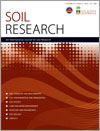SR14353Changes in soil quality and carbon storage under biofuel crops in central Ohio
Impact of annual biofuel crops (corn, sorghum) and perennial grasses (switch grass, miscanthus, prairie mix) were assessed on soil properties and soil organic carbon (SOC) stocks in Central Ohio. Perennial energy crops improved soil properties in terms of lower soil bulk density, higher porosity, improved water-stable aggregates and higher mean weight diameter compared to annual crops maize and sorghum. The SOC stock in the 0–10 cm layer was significantly higher under switch grass and miscanthus than that under sorghum.




